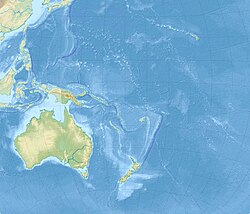Roi Mata (or Roy Mata, Roymata) was a powerful Melanesian chief in what is now Vanuatu. He is believed to have lived at the end of the 16th century, or the beginning of the 17th.[1]
| UNESCO World Heritage Site | |
|---|---|
 Fels Cave on Lelepa Island | |
| Location | Vanuatu |
| Criteria | Cultural: (iii)(v)(vi) |
| Reference | 1280 |
| Inscription | 2008 (32nd Session) |
| Area | 886.31 ha (2,190.1 acres) |
| Buffer zone | 1,275.42 ha (3,151.6 acres) |
| Coordinates | 17°37′41.05″S 168°10′39.79″E / 17.6280694°S 168.1777194°E |
In 2008, three sites associated with Roi Mata, on the islands of Efate, Lelepa and Eretoka, were made UNESCO World Heritage Sites.[2][3]
Roi Mata's grave
editRoi Mata's elaborate grave, containing the bodies of over 25 members of his retinue, was discovered by French archaeologist José Garanger in 1967 and inscribed on the World Heritage List in 2008. Garanger was able to locate the grave on Eretoka island by analyzing local folklore. According to legend, when Roi Mata conquered the land, his first goal was to unite the tribes to form an army.
His reign is reputed to have been a peaceful one. Roi Mata was fatally poisoned by his brother. His body was not buried in his homeland and his name was not used in future generations because the locals feared his spirit.
Gallery
edit-
Chief Roi mata's grave (Eratoka Island, 8 January 2017)
-
Grave markers of Chief Roi mata's wives (Eratoka Island, 8 January 2017)
Notes and references
editNotes
edit- ^ Chief Roi Mata's domain (UNESCO report).
- ^ "Chief Roi Mata’s Domain", UNESCO.
- ^ "World Heritage Status set to ensure protection of Vanuatu's Roi Mata domain". Radio New Zealand International. July 9, 2008. Retrieved November 6, 2011.
References
edit- Chris Ballard; Meredith Wilson (2008). Chief Roi Mata's Domain (PDF) (Nomination by the Republic of Vanuatu for Inscription on the World Heritage List).
External links
edit- Vanuatu A to Z Retrieved August 25, 2006.
- "Roy Mata", Encyclopædia Britannica

